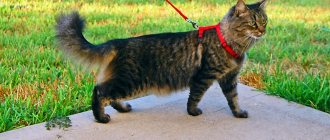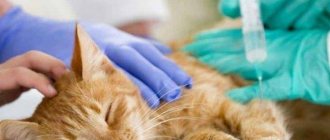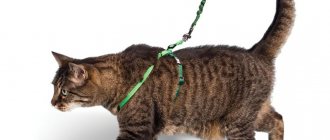Before walking with an animal, a logical question arises: how to quickly put a harness on a domestic cat? Letting your cat walk on its own is the height of irresponsibility. Roads in the city are sprinkled with chemicals, garbage is scattered, and dogs are allowed out without a leash. If frightened, your pet will easily get lost or run away. A purebred cat can easily be stolen or considered lost.
There are several types of leashes for cats. The choice depends on the personal preferences of the owner and his budget. For example, a harness-vest costs more than a regular belt. Types of harnesses:
- "eight";
- V-shaped;
- H-shaped;
- harness-vest.
Below is a photo of how to put any harness on a domestic cat so as not to harm it.
Factors to consider:
- belt width. Narrow belts cut painfully into the body. The optimal width is 1–2 cm;
- strong fastenings. Weak clasps can break or come undone;
- There should be a small space between the body and the straps; it will not allow the cat to escape, but will not restrict movement.
Types of harnesses
At the moment there are several types of harnesses:
- eights;
- vests and overalls;
- Y-harnesses;
- V-shaped harnesses;
- H-type;
- models with two jumpers.
Harnesses can be of different types
Below are more details about each of the presented types.
Eights
Y-harnesses
A Y-harness is the same as a figure eight harness, only it has a jumper on the chest. The scheme is exactly the same as the previous version: two (or more) straps are fastened together in one place.
Vests and overalls
Vests and overalls are decorative options. They cost more than regular models. Sewn from cotton, linen, synthetics. The length of the fasteners on the neck and stomach is adjusted using special sliders, which are installed on the main strap with a plastic carabiner.
Note! The design is different. You can choose a model to suit your taste and color.
V-harnesses
For your information! This is considered to be the simplest and most common model.
Here 2 rings are connected to each other by a jumper, which will be located on the back of the animal. It is made from nylon, tightly sewn together threads.
Models with two jumpers
The least common models are those that have 2 jumpers: one on the back, the other on the chest. As a rule, they are more expensive than other types of this type of ammunition (with the exception of vests and overall models).
Note! Models are sold with and without a leash. The cost of the product in the pet store also depends on this.
How does a harness with two jumpers work?
Scheme of putting on different types
The simplest are considered to be figure-eight harnesses, which consist of two loops. When put on, they are fixed on the neck and torso, under the cat's front paws. There are varieties without a collar; they are more comfortable for animals.
However, the owners do not really like the latter option; it is more difficult to control the animal. Type H harnesses are similar to the previous ones, but there is a bar between the loops. Harnesses-vests are more expensive, but they also have more functionality. The equipment is similar to clothing and has comfortable fasteners. This is a great option for the off-season. This harness will protect your cat from dirt and cold.
Figure-of-eight harness
The design resembles intertwined straps that fasten to the body. The step-by-step instructions for putting on a harness and collar are as follows.
- Place the first loop around the cat's neck. Make sure that the ring for the leash is located on top, at the withers. If everything is correct, then the fasteners are on the bottom.
- Widen the large loop so that the paws fit through. The jumpers should be located on the chest, clearly in the middle.
- Thread the cat's paws one at a time into the loop formed.
- Fasten the strap under the paws or on the back.
- Attach the leash to the ring at the top.
The design, which is more convenient for the cat, does not have a collar. This option is presented in the form of 2 loops for paws. Put it on like this.
- Lay the harness on the floor or other surface.
- Place the cat's front paws into the triangles.
- Raise the belt and fasten it at the top of your back. Attach the leash carabiner.
Harness-vest
The models differ; the one-piece part can be located both on the stomach and on the back. The first ones are especially important to put on a kitten. Since such equipment resembles clothing, the donning scheme is similar. Usually there are no straps; Velcro and ties are used as fastenings. Wear a harness with fabric on the back like this.
- Place the whole part on your back. The fastening for the carabiner of the leash should be located clearly at the withers of the animal.
- Insert the paws into the different holes.
- You need to carefully fasten or tie, depending on the type of fastening, the ammunition on your neck and stomach.
- Make sure you don't fasten the harness too tightly. To do this, insert 2 fingers between the structure and the cat’s body; they should fit freely.
- Attach a leash or tape measure to the loop on your back.
Harness vests with fabric on the chest are less common. They are much easier to put on than the previous look. Take it step by step.
- Gently place the cloth on the cat's belly.
- Place the animal's front paws one by one into the corresponding holes.
- Connect the parts of the harness on the top of your back. Secure the ammunition with fasteners.
- Make sure the straps are not too tight. Otherwise, the animal will have difficulty breathing and may even experience pain.
- Attach the leash to the top ring.
V-harness - step-by-step instructions
The holding device protects the cat from eating waste, attacks by other animals, and loss. This type is distinguished by a fastening on the back, visually similar to the Latin V. The long belt is presented in the form of two loops.
Recommend: Wheelchairs for cats
It’s easier to put on than a figure eight. Long loops are for paws. Instruction:
Step-by-step photo instructions on how to quickly put a V-shaped harness on a cat. This type of device is convenient because it minimizes interaction with the animal.
Features of making ammunition for kittens
Accessories for kittens are made according to the same principle as for adult animals. True, when sewing, you can use a base of smaller width (1.5 cm), as well as softer fabric (velor, fleece).
Accustom your small pet to a collar, leash and walks starting at 2-3 months of age after vaccination. To prevent your baby from being scared of new objects, let him get to know them in advance. Let the animal sniff the ammunition, play with it, or even sleep.
Young animals are much easier to train to walk on a leash than adults.
A walk down the street can give many new experiences to both the cat and its owner. To avoid unexpected troubles, it is better to choose safe walks on a leash. The ammunition necessary for this can be made with your own hands with minimal expenditure of money and time. Don't be afraid to experiment!
Vest for a cat, instructions
The vest fastens with Velcro and is worn like regular clothing. It warms the animal and does not put pressure on the pet’s body. Even playful cats can easily tolerate the presence of a jacket if it is chosen correctly.
- the vest is applied to the cat’s back, so that the ring for the long leash is at the top;
- paws are pushed into the holes;
- Velcro sticks together on the neck and stomach;
- The leash clings to a loop on the back.
A harness and jacket for a cat is a more convenient solution compared to straps: below are photo instructions.
Jumpsuit options
Immediately after the purchase and the decision to go for a walk for the first time, you will have to figure out how to put the harness on the cat.
This is not difficult to do if you have an idea about the device. The design of the harness meets primarily the physiological characteristics of the animal and safety issues. Cats differ from dogs in having poorly developed neck muscles. To avoid injury when walking, regular collars are not used on them, like for dogs. The leash in cat gear is attached not to the collar, but to a special device - a harness. Beginning cat breeders do not always have an idea of what a cat harness is.
The equipment for walking a fluffy beauty is a structure that is attached not only to the neck, but also to the chest of the animal. Most often, the device is made of cotton or nylon fabric.
| Types of cat harnesses | What is | Photo |
| Figure-of-eight | It consists of two loops that are put on the neck and body of the animal. Both loops are fixed on the cat's back. This design prevents the animal from slipping out of the equipment, and also relieves the muscles of the neck and back. | |
| H-shaped | The design of such a harness is similar to a figure-of-eight, but is equipped with an additional bar connecting the two loops. Observing the animal from above, you can see that such equipment looks like the letter H. This type of harness is suitable for large representatives of the cat family | |
| V-shaped | A harness of this design looks like a Y when viewed from the front of the cat. The ammunition evenly distributes the load on the animal’s muscles without causing strain in the neck area | |
| Harnesses-jackets | These are wide devices covering the neck, entire chest and part of the back of the animal. In addition to its direct purpose, such ammunition protects the cat from pollution, thorns, and prevents hypothermia. |
Experienced owners usually choose H and Y-shaped designs. They securely and at the same time safely secure the animal. In the cold season, harnesses and jackets have proven themselves to be excellent.
Why does a cat need a harness?
In megacities, it is better for cats to walk under control
With supervised walks, you can be sure that your animal:
- will not get lost;
- will not eat any nasty things;
- will not be attacked by cruel people, aggressive relatives and dogs, annoying children;
- won't get hit by a car.
Not all cats will benefit from walks (and therefore the use of a harness). You should not insist on walking if:
In addition to walking, harnesses with a leash can be used when visiting the veterinarian, traveling in public transport or at exhibitions.
Why do you need street ammunition?
Many owners of cats, especially those that are not bred, let their pets go for an independent walk in the yard. And outside the home, small predators face dozens of troubles in the form of yard cats guarding their own territory, aggressive dogs and cars. It’s not worth reminding once again about the possibility of infection with parasites (fleas, ticks, lice eaters). In addition, cats are freedom-loving creatures and it is often not so easy to return them home.
A pet on the street faces many other dangers from people. And a trip to the veterinarian or a trip will become a difficult mission if the cat does not want to sit in the carrier. But what to do if you can’t keep a curious freedom lover at home? There is an exit! You can walk your fluffy, controlling his freedom of movement. Fortunately, today the choice of accessories is quite wide.
How to put a harness on a cat
Before putting a harness on your cat, practice on a stationary object.
Figure-of-eight harness
Option for figure eight with attached straps:
- Unfasten both straps.
- Let's take the cat.
- Fasten the neck strap.
- The place for attaching the leash is located clearly between the shoulder blades.
- Fasten the strap around the body.
- Attach a leash.
Option for team eight:
H-harness
We put H-shaped harnesses on the pet like this:
- Unfasten both rings.
- Let's take the cat.
- Fasten the neck ring.
- We place the jumper between the shoulder blades.
- Fasten the chest ring.
- We attach the leash.
Y-harness
This model has two options. In the first, the neck strap is unfastened, in the second - not.
In the first case:
- We put the neck ring on the cat.
- We insert the cat's paw into the formed triangle.
- Make sure that the jumper goes through the center of the chest.
- Fasten the chest ring.
- We attach the leash.
Video: how to assemble and put on a Y-harness
Harnesses with two jumpers are put on in the same way.
V-harness
These models are very easy to put on; you just need to lay them out on the floor, place the animal’s front paws in triangles, and then fasten the clasp and attach the leash.
V-shaped harnesses are the easiest to put on a cat.
Video: how to put a V-harness on a cat
Harness-vest
These types of harnesses come with fasteners both on the stomach and chest, and on the back. In the first case, you simply wrap the cat with a harness and fasten it at the bottom. In the second, you put the paws through the holes and fasten them on the back.
I recommend: How to get rid of cat hair in an apartment: examples at home
Jumpsuit options
Immediately after the purchase and the decision to go for a walk for the first time, you will have to figure out how to put the harness on the cat. This is not difficult to do if you have an idea about the device. The design of the harness meets primarily the physiological characteristics of the animal and safety issues.
Cats differ from dogs in having poorly developed neck muscles. To avoid injury when walking, regular collars are not used on them, like for dogs. The leash in cat gear is attached not to the collar, but to a special device - a harness. Beginning cat breeders do not always have an idea of what a cat harness is.
The equipment for walking a fluffy beauty is a structure that is attached not only to the neck, but also to the chest of the animal. Most often, the device is made of cotton or nylon fabric.
| Types of cat harnesses | What is | Photo |
| Figure-of-eight | It consists of two loops that are put on the neck and body of the animal. Both loops are fixed on the cat's back. This design prevents the animal from slipping out of the equipment, and also relieves the muscles of the neck and back. | |
| H-shaped | The design of such a harness is similar to a figure-of-eight, but is equipped with an additional bar connecting the two loops. Observing the animal from above, you can see that such equipment looks like the letter H. This type of harness is suitable for large representatives of the cat family | |
| V-shaped | A harness of this design looks like a Y when viewed from the front of the cat. The ammunition evenly distributes the load on the animal’s muscles without causing strain in the neck area | |
| Harnesses-jackets | These are wide devices covering the neck, entire chest and part of the back of the animal. In addition to its direct purpose, such ammunition protects the cat from pollution, thorns, and prevents hypothermia. |
Experienced owners usually choose H and Y-shaped designs. They securely and at the same time safely secure the animal. In the cold season, harnesses and jackets have proven themselves to be excellent.
Owner reviews
Oh, it's Friday. In general... We looked for a harness for a long time... Then we started putting it on... Something began to happen. This face tore us all apart!! In general, they didn’t dress her... That’s where the party ended... Well, to hell with her. He doesn’t want to go for a walk and there’s no need to!!
gutik
https://forums.zooclub.ru/showthread.php?t=464&page=2
And we put on a leash on the street, when there are already a lot of distractions and the cats don’t notice the leash, it freezes, and here we are, quickly put it on and ran through the bushes.
Mavra
https://forums.zooclub.ru/showthread.php?t=464&page=2
Karlushka
https://forum.mau.ru/viewtopic.php?p=4770204
Calvados
https://forum.mau.ru/viewtopic.php?p=4770204
Katrishka
https://forums.zooclub.ru/showthread.php?t=464&page=2
Putting a harness on a cat
The general rules for putting on a harness are simple:
When putting on a harness, it can be difficult to determine which loops to put on where, in this case, focus on the carabiner, it should be located in the neck or back area
The cat may begin to resist and refuse to walk in a harness or leash.
It is correct to accustom your pet to a harness from childhood, putting it on once every few days for 5-10 minutes. But if childhood has already passed, and the need for walks on a harness exists, then you need to accustom an adult animal gradually.
First, it is better to teach your cat to walk in a harness and on a leash without leaving the house.
The training itself will consist of three stages:
Once the cat understands that the harness is associated with a walk outside, most likely its attitude towards this item will change for the better
My conclusions about the H-shaped harness: the suede did not rub, the design is comfortable and reliable, but if you want, you can slip out of it, especially if you try hard. Disadvantages: it is very inconvenient to fasten the short leash - our Leo did not have enough of it.
Leo in an H-shaped harness made of black suede
Main rules
For convenience, I have compiled a list of universal tips that will help you painlessly accustom your pet to an unusual accessory.
- Give your cat a chance to get used to the new thing. I left the strap in sight and gave it time to sniff.
- Always follow the instructions.
- If the cat resists, do not try to force it or yell at it. Let go, calm down and try again after a while.
- Getting used to the strap is stressful for the animal, so go outside only after making sure that the cat is calm and ready for a walk.
- Make the first 2-3 exits in a quiet and safe place, where there are no loud noises or dogs.
- Give your cat a treat when you dress him to make the process an enjoyable experience.
- Two fingers should fit freely between the harness and the cat's body. Use this method to check if your straps are too tight.
How to wear a harness with a solid back or chest
Vest harnesses and overall harnesses are the easiest to put on because they resemble human clothing and are put on in a similar way. The difference between the models is the location of the solid fabric - on the back or on the chest.
The overall harness usually does not have straps and is fastened with Velcro. This harness is more expensive than all other options, but it is practically not felt on the body and is suitable for sensitive cats who do not want to get used to harnesses.
Harness-overalls are more suitable for the cold season
Full back harness
On the solid back of the vest there is a ring for attaching a leash, and the fasteners are located below: one, usually on the pet’s neck, and the second on the stomach, between the front and hind legs. It's easy to put on:
I recommend: How to properly comb a cat: frequency and technique
A common and comfortable type of harness for cats, which is also easy to put on.
Full breast harness
Such vests are less common, but they are even easier to wear. One-piece fabric is located on the chest and stomach, and fasteners are on the back.
A type of harness that is rarer for cats, more often used for small dogs
First experiments
Experienced owners recommend doing the following: take the cat outside in a carrier bag so that there is an opportunity to explore the environment from a “safe distance.” And only then provide the opportunity to walk on a leash. This is how the owner will be able to study the behavior of his cat outside his usual apartment and accurately determine whether the pet needs regular trips outside.
Having chosen the most suitable area, the pet is carefully lowered to the ground. Don’t be distracted by your phone or conversations with friends, control every step and surroundings, because at any moment a stranger or a dog without a leash may appear. Give the cat the opportunity to satisfy its curiosity, do not pull it away from every bush (such actions can cause injury to the animal).
Make sure that your household does not pick up anything from the ground. Do not let him near the carcasses of small rodents or birds. Avoid contact with other cats, which may provoke aggression. Don't let it go too far.
The first walk should not last longer than 10-15 minutes. Only in the future is it possible to increase the time to 30-40 minutes, when the purr adapts to new conditions. Individuals on their own determine the duration of their travel.
And at the dacha you can without a leash
Reviews
AsyaJust Asya
https://irecommend.ru/content/vygulivaem-koshku
Lenochek91
https://irecommend.ru/content/deshevo-i-udobno-odevaetsya-foto
Burbuzyaka
https://irecommend.ru/content/khoroshaya-shleika-po-dostupnoi-tsenefoto-gulyayushchego-koteiki
Lyudmilabagira 98
https://otzovik.com/review_3609426.html
ycb1
https://popgun.ru/viewtopic.php?f=113&t=246046
Karlushka
https://forum.mau.ru/viewtopic.php?p=4770204
Calvados
https://forum.mau.ru/viewtopic.php?p=4770204
DarlingS
https://teron.ru/index.php?showtopic=2202006
In what cases is it prohibited to lead a cat on a harness?
A cat on a harness has the opportunity to walk outside - this is a definite plus. However, not all cats need walks, and sometimes they are completely contraindicated.
Walking, with or without a leash, is contraindicated in several cases:
During the period of heat, it is better to refrain from leaving the house.
After serious operations or injuries, according to the veterinarian, it is necessary to reduce the number of walks or abandon them altogether.
In the absence of vaccinations, it is better not to take the cat outside or to the dacha - a pet with low immunity can easily contract a dangerous disease, even if it just sniffs a blade of grass.
Until the kitten reaches the age of 5-6 months, it is better to refrain from walking.
If a cat is terrified of the street, there is no need to force it to walk - many mustachioed cats are content with walking on the balcony or looking at the outside world through the window.
The list goes on for a long time; There are several reasons for refusing to go for walks. If your cat doesn't feel well or wants to sleep on the sofa, you shouldn't give him a walk - this will bring extra stress.
How to accustom a cat to a leash and harness
Cat harness: main types and DIY options
It is recommended to accustom your pet to equipment from an early age. It is easier for young individuals to adapt to something new. Do not make sudden movements or forcefully put on the harness. In this case, the cat will form the wrong attitude towards this attribute.
- The cat should be given the opportunity to familiarize itself with the new item. The pet needs to be convinced that this does not pose any threat.
- If an item has an unpleasant (or disgusting) smell, you should wash it and dry it so that the persistent aroma disappears. Then it will be easier for the animal to accept new ammunition. You can put a harness in the place where your furry couch potato usually sleeps.
- After the pet begins to calmly perceive the attribute, you can try putting it on. Everything is done in a calm environment, without sudden movements.
- When a cat tries to resist, you first need to calm her down, let her relax, and then try again.
- After several attempts, the animal should be comfortable with the harness. Your pet should walk around the apartment like this.
- Only after this can you attach a leash to the harness and leave your pet for a while. A positive attitude towards the next new subject should be formed.
- Then, when the cat begins to calmly perceive everything, you can begin work: first, you should try to follow him around the apartment, and then teach him to walk in the direction the owner is going.
- After these lessons, the animal can be taken outside. In order for the cat to feel normal, it is recommended to take the first walk in a park, a deserted place, away from areas where dogs are walked. Also, there should be no extraneous noise, rumble, cars or other external irritants on the site.
Important! If a furry couch potato is under one year old, has no vaccinations and is having a very hard time getting used to a new environment, walking is not recommended, as the pet may develop uncontrollable panic while being outside. Also, you should not take a recently operated cat or a cat that is in late stages of pregnancy, or elderly cats that have never been outside, outside.
Walking on a harness is preceded by a long training period.
Walking with an animal is a process that should bring pleasure to the owner and pupil, and not stress and panic attacks. To avoid negative consequences when training a cat to wear a harness, you need to do everything gradually. You cannot forcefully put on ammunition, otherwise a negative attitude will form towards the item.
How to choose a model and size
Don't rush to purchase the product right away. The ideal option would be to buy a harness with your pet, but if this is not possible, pay attention to the following nuances:
the optimal material is cotton or nylon, the fabric will not rub the animal’s body and get very dirty;
1.5 centimeters is the ideal width of the straps, since a wider version will restrict the pet’s movements, and a narrower one will rub and tighten;
fastenings should be easy to unfasten and fasten - this guarantees the durability of the device;
Is there a mechanism for attaching a leash?
Dimensional features
Just like with human clothing, you need to choose the appropriate harness size. This ensures that it sits comfortably, evenly, in the places specified for the design.
How to choose the size of a harness for a kitten
The size is usually indicated directly on the packaging. Approximate parameters correspond to the size of a cat at a certain age and body weight.
The following markings exist:
- S (small) – for kittens, small breeds.
- M (medium) – medium size.
- L (large) – for large and very large breeds.
Before purchasing, measure your pet's girth under the front legs and the length of the back from the shoulder blades to the tail. Most harnesses are adjustable with belts, so add 5-7 cm (1-2 fingers to the body) to the result, “for growth.” Check your results with the harness packaging and buy the exact size.
In addition to the length of the straps, it is important to check the width. The larger the pet, the wider the straps it needs. Otherwise, the structure will dig into the body uncomfortably. On average it is 1 – 1.5 centimeters.
Training and walking rules
The optimal time for getting used to is 5-10 minutes. It is better if the short-term procedure is repeated more than once. Make time for exercise before meals and then feed your pet - then your cat will associate it with something pleasant.
Try to do what the animal wants: run with it, wait, just be close, and soon the pet will get used to it. When the cat is completely comfortable, you can go outside with a leash.
What does it represent?
Almost every cat needs at least rare walks in the fresh air, which strengthen the immune system, prevent the development of heart and vascular diseases, and also reduce the likelihood of developing obesity. To make walking easier, it is recommended that owners purchase a special harness from a pet store, which comes in several types. It is especially important to think about purchasing a collar for residents of large cities, where a cat can easily get lost. In the store you can purchase a harness for kittens and adults, but you need to follow a special sequence of actions in order to attach it correctly. Such a cat accessory has a number of advantages:
- convenient design;
- reliability of fixation;
- minimal risk of choking when the leash is pulled tightly;
- It is delicate and does not injure the cat’s fur and skin.
Veterinarians note that it is better to purchase a harness for walking cats rather than a collar. This is due to the fact that in the latter case the load on the pet’s neck muscles increases, which can lead to some pathologies.
Such products are manufactured under the Trixie brand.
There are different manufacturers that make cat harnesses, but the most popular are:
- Trixie;
- Dezzie;
- Papillon;
- Yami-Yami.











